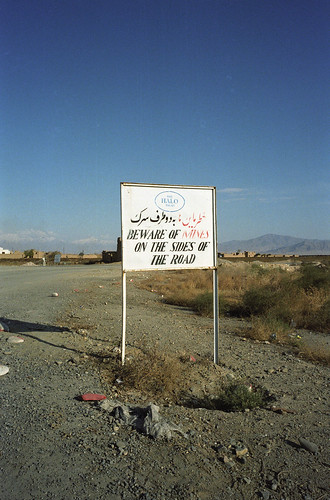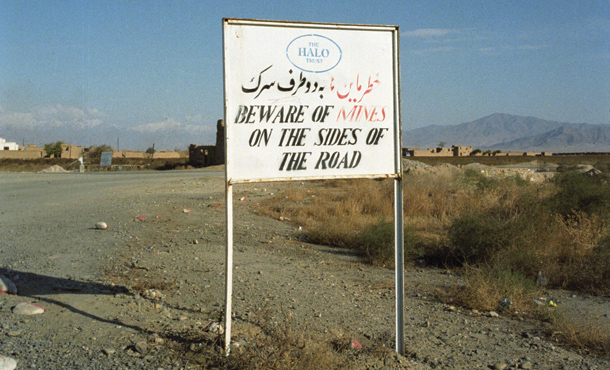These are excerpted, sometimes paraphrased, from the concluding chapter of Descent Into Chaos – The U.S. and the Disaster in Pakistan, Afghanistan, and Central Asia by Ahmed Rashid.
- Take a multi-prong approach: No single military, development or political solutions.

Landmines, often from former wars, remain a threat. - Involve every entity with a stake in this matter: Pakistan, India, United States, European Union, NATO, UN, Iran. All of these powers have been interfering in Afghanistan for their own reasons, but all also have a stake in stabilizing the region.
- Talk to the insurgents: Seek a political solution that wins the cooperation of as many Afghan and Pakistani insurgents as possible. Enlist their cooperation against al-Qaeda, which has a global agenda that may be different than their more local, community-based interests.
- Commit to a multi-year, long-term international development aid package for regional economic integration, education, and job creation programs in the borderlands between Afghanistan, Pakistan, and Central Asia. Quick fixes look cheap initially, but they aren’t, because they don’t work and just leave people feeling more angry and hopeless.
- Pakistan: Pakistan’s strategic goals in Afghanistan place it at odds not just with Afghanistan, India, and the United States, but with the entire international community. Yet the UN Security Council has hardly discussed Pakistan’s role in Afghanistan. The Pakistani army has to put to rest its notion of a centralized state based solely on defense against India and an expansionist Islamist strategic military doctrine carried out at the expense of democracy.
- Iran: The United States needs to talk directly with Iran, a Shiite Muslim nation. Iran has reacted to threats by aiding insurgents in Afghanistan (who are not Shiites) in order to signal how much damage it could do in response. However, Iran’s real interests lie in seeking cooperation with the United States and the international community against al-Qaeda and the Taliban.
- India/Pakistan: To avoid military stratagems, establish a permanent way for the Indian and Pakistani governments, including their military and intelligence personnel, to consult with each other over complaints and conflicts.
- Russia/China: To reduce jockeying for influence, address the legitimate concern of Russia and China that the United States and NATO are seeking a permanent Western military presence in countries on the borders of Russia and China.
- Afghanistan: The Afghans need to evolve a system of governance capable of delivering services to the people and relatively free of tribalism, sectarianism, and corruption. They need to tackle the drug problem themselves and show the world that they will assume responsibility for their nation in the quickest possible time.
- Central Asian Republics: Peace in the greater region requires stable neighbors – Kazakhstan, Kyrgyzstan, Tajikistan, Turkmenistan, and Uzbekistan. All five countries sit atop vast energy reserves, offering the potential for their peoples to emerge from poverty. Yet all are ruled by repressive regimes whose policies have fueled militant Muslim resistance groups, reminiscent of the Taliban. China, Russia, and the United States are waging a “New Great Game” for influence in Central Asia. It is time to stop repeating the historical tragedies seen in Afghanistan and to learn from them: the best guarantee of security for all concerned is laying the groundwork for satisfied citizenry in these countries, as is true elsewhere.

